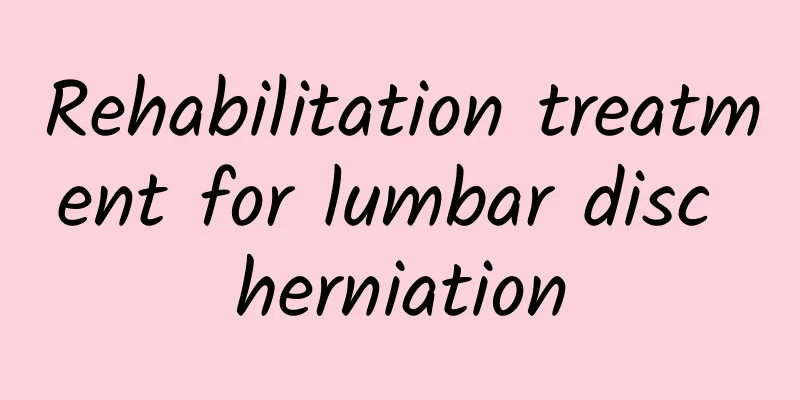Rehabilitation treatment for lumbar disc herniation

|
Lumbar disc herniation is one of the common diseases in orthopedics. It is mainly caused by degenerative changes in the various parts of the lumbar disc (nucleus pulposus, annulus fibrosus and cartilage) to varying degrees. The annulus fibrosus of the disc ruptures, and the nucleus pulposus tissue protrudes (or falls out) from the ruptured part to the back or inside the spinal canal, causing the adjacent tissues such as the spinal nerve roots, spinal cord, cauda equina, etc. to be chemically stimulated or physically compressed, and a series of clinical symptoms appear. What are the specific symptoms? (1) Low back pain. Most patients with lumbar disc herniation have a history of low back pain for several weeks or months, or a history of recurrent low back pain. (2) Radiating pain in the lower limbs. Pain radiates from the waist or buttocks to the calves or heels. (3) Intermittent claudication. This refers to lower limb pain and weakness after walking a certain distance. The symptoms can be relieved by bending over or squatting to rest, but reappear when walking again. (4) Numbness. Some patients often experience numbness in their limbs, which is also caused by nerve compression. (5) In severe cases, lower limb muscle atrophy, paralysis, and incontinence may occur. In the past, if you had a herniated lumbar disc, you might have had to undergo surgery or stay in bed. But now, we can use a wealth of rehabilitation knowledge to regain our health. 1. Bed rest Bed rest is still necessary. The bed rest time is preferably 4 to 7 days. Absolute bed rest is best not to exceed 1 week. Too long a time can cause muscle atrophy due to disuse, cardiovascular disease and osteoporosis. The bed should be wide enough and hard, and the patient can fully relax the spine after lying flat. Too soft mattresses are not suitable for patients with low back pain, as they will cause the spine to be in a scoliotic state and cannot rest. A bed with appropriate hardness and softness is not only necessary for patients with low back pain, but also beneficial to everyone. 2 Traction therapy Traction is divided into fast traction and slow traction. Among them, slow traction includes many methods, such as autogenous traction (gravity traction), pelvic traction, bilateral lower limb skin traction, etc. It is suitable for low back pain caused by lumbar disc herniation, lumbar degeneration, acute lumbar sprain, and lumbar facet joint disease. It has a long action time and a small applied weight. Most patients are more comfortable during traction. During traction, the traction weight can be increased or decreased according to the patient's feeling. The adverse reactions are also less than fast traction. However, due to the long traction time, heavy chest and abdominal compression, and certain restrictions on respiratory movements, it should be used with caution for the elderly, especially those with cardiopulmonary diseases. 3. Physical therapy It is suitable for patients with various types of lumbar disc herniation. Its main purpose is to relieve pain, reduce inflammation, promote tissue regeneration, stimulate nerves and muscles, loosen adhesions, and promote the recovery of waist and affected limb functions. Commonly used physical factors include: ultrashort wave, direct current drug ion introduction, interference electricity, low-frequency modulated medium-frequency electricity, infrared, ultraviolet nerve field irradiation, etc. 4. Exercise therapy Correct posture and movements in daily life are the fundamental ways to prevent the onset of back and leg pain caused by lumbar disc herniation. Patients with lumbar disc herniation should actively cooperate with exercise therapy. The purpose of treatment is to increase the tension of the waist and back muscles, change and correct abnormal force lines, enhance ligament elasticity, move intervertebral joints, and maintain the normal shape of the spine. Stretching training increases the toughness of the waist and back, and waist and abdominal muscle strength training increases the stability of the spine. The popular science content of this platform has been funded by the China Association for Science and Technology's Science Popularization Department's 2022 National Science Literacy Action Project "National Society Science Popularization Capacity Improvement Project-Rehabilitation Science Popularization Service Capacity Improvement Action Plan" |
<<: Baby's first umbrella of protection - primitive reflexes
>>: Postural management at home for congenital muscular torticollis
Recommend
What to do if the areola is bitten by the baby? What to do if the baby bites the nipple
Many mothers will have their areola bitten by the...
How to relieve constipation during pregnancy
Pregnant women are prone to constipation, so what...
Immunotherapy for fetal demise
In fact, many friends do not know what fetal grow...
Reasons for low progesterone during pregnancy
Every mother has hardships and difficulties after...
Will you feel anxious during early pregnancy?
The early and late pregnancy are the two most unc...
How to do a strength training plan for women?
Girls are naturally weak and easily vulnerable to...
Women who have caesarean sections don't live long
Many women are afraid of the process of natural c...
What can women eat to enlarge their breasts?
Women's breasts have always been a symbol of ...
How is Ximai oatmeal? Edible value of Ximai oatmeal
When you go to the supermarket to buy food, you c...
Some things you may not know about CT radiation!
Author: Zhang Tian China Rehabilitation Research ...
Precautions after IUD removal
The IUD removal surgery is to remove the contrace...
What are the ways to exercise breasts for women?
Many women do not pay attention to the growth of ...
What causes uterine prolapse?
Uterine prolapse is a very common phenomenon. For...
Harris: Survey shows that mobile apps that use rewarded installations are often deleted after downloading
According to an online survey conducted by Harris...
How many days does vaginal bleeding last after abortion?
Nowadays, people have more open-minded ideas. If ...









